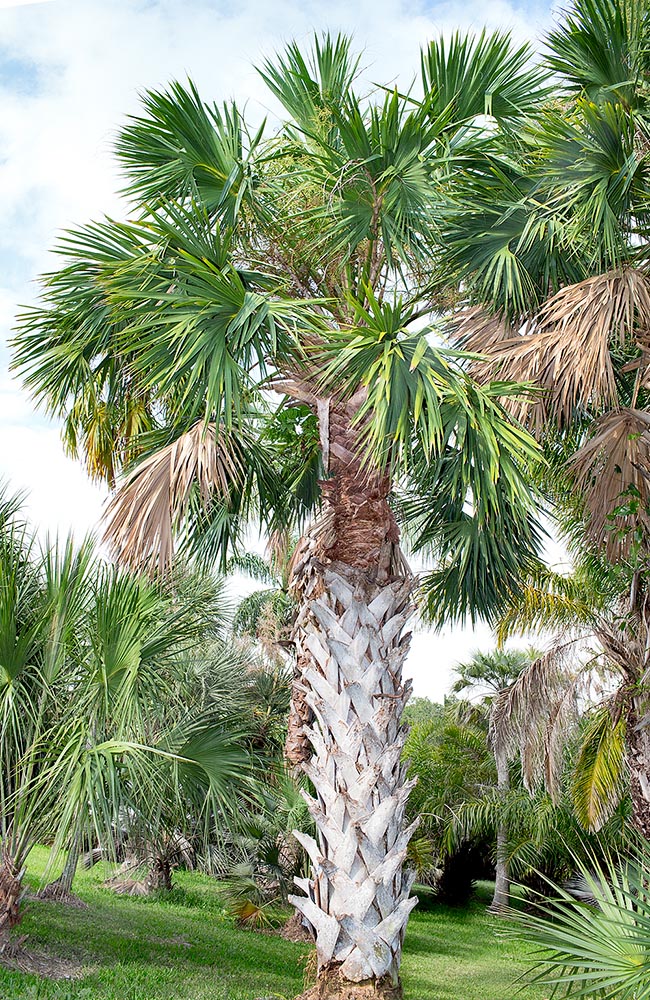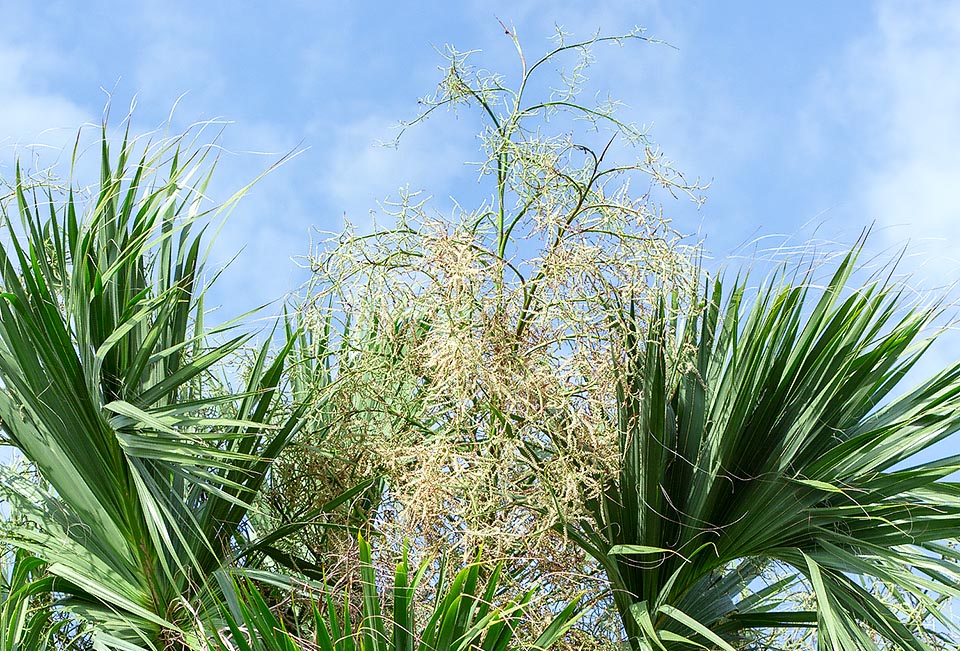Family : Arecaceae

Text © Pietro Puccio

English translation by Mario Beltramini

Native to Mexican area, Sabal mexicana has an erect, solitary wrinkled and columnar stem that can reach the 15 m of height with about 20-35 cm of diameter. The showy remnants of the foliar bases form a typical cross-weave © Giuseppe Mazza
The species is native to El Salvador, Guatemala, Honduras, Mexico (Guerrero, Oaxaca, San Luis Potosì, Tamaulipas, Veracruz e Yucatan), Nicaragua and USA (southern Texas) where it lives in the dry forests as well as in the humid ones, in the alluvial plains, swamps and on the margins of water streams, on clayey-calcareous soils, at low altitudes.
The etymology of the genus is unknown as it has not been specified by the author, the French botanist Michel Adanson (1727-1806); the specific name is the Latin adjective “mexicanus, a, um” = of Mexico, with reference to the place of origin of the species type.
Common names: Mexican palmetto, Rio Grande palmetto, Texas palmetto, Victoria palmetto (English); palma de sombrero (El Salvador); guano, palma de escoba (Guatemala); apachite, guano, guano bon, palma de llano, palma de micheros, palma marrachada, palma real, palma redonda, soyate, xa’an (Messico); palma de techo (Nicaragua).
The Sabal mexicana Mart. (1838) is an unarmed monoecious species with solitary stem, erect, columnar, up to 15 m tall and 20-35 cm of diameter, wrinkly and of greyish brown color, covered for a long tract by the residues of the foliar bases forming a typical cross-weave.
The leaves, on a 0,9-1,8 m long petiole, are costapalmate, 1,5-2,2 m long and broad, divided in 80-110 rigid segments with long pointed bifid apices, 3-5 cm broad, filamentous at the margins, united at the base per about 1/3 of their length, of glossy dark green color; triangular hastula (appendage located in the point of insertion of the foliar lamina with the petiole) with acute apex 9-15 cm long.
Inflorescences between the leaves almost of the same length, on an extremely short peduncle, arcuate, with 3 orders of ramifications, and tiny slightly fragrant whitish flowers. Slightly depressed globose fruits, of 1,4-1,9 cm of diameter, blackish brown when ripe, edible, containing only one globose-depressed seed, of 0,9-1,3 cm of diameter, of reddish brown color.
It reproduces by seed, previously kept in water for 3 days, in draining loam maintained humid at the temperature of 24-28 °C, with germination times starting from 1-3 months.
Slow growing species, but early in flowering, similar to the Sabal palmetto, from which differs due to the bigger size of the fruits, besides particulars of the inflorescence, cultivable in the regions with tropical, subtropical and temperate climate, where adult specimens may bear values of temperature, if exceptional and short lasting, up to -10 °C.

Inflorescence with 3 orders of ramifications, and tiny whitish flowers slightly fragrant. The fruits, of 1,4-1,9 cm of diameter, of blackish brown color when ripe, are edible. The leaves, once mainly utilized as cover for rural dwellings, today serve to fabricate the sombreros and artistic and folkloristic intended for the tourist market © G. Mazza
It grows in full sun as well as in partial shading, it adapts to an ample variety of soils, sandy to heavy, slightly acidic to alkaline, and can resist dry periods, but with an even slower growth.
The old leaves are still now utilized, due to their long duration and their low cost, for the covering of rural dwellings and for shading nurseries, chicken coops, etc., whilst with the young leaves and the fibers obtained from the petioles are realized various handicrafts of common use, in the first place the typical headgear (“sombreros”), and artistic and folkloristic intended for the tourist market.
Synonyms: Inodes texana O.F.Cook (1901); Sabal guatemalensis Becc. (1908); Sabal texana (O.F.Cook) Becc. (1908); Inodes exul O.F.Cook (1913); Sabal exul (O.F.Cook) L.H.Bailey (1916); Inodes mexicana (Mart.) Standl. (1920); Erythea loretensis M.E.Jones (1933).
